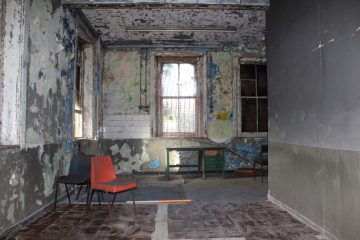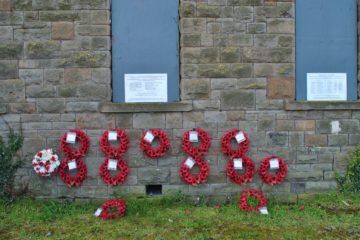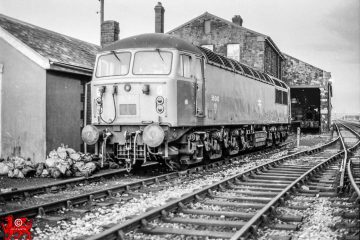I worked at the Llanelli Goods Shed between 1960 and 1964, initially as a Messenger boy. I was transferred to Neath in 1964, Swansea in 1965, and Gowerton North in 1966 when I was ultimately made redundant by British Rail as a steel checker. I was a Lad Porter up to the age of 16, then a Porter and Leading Goods Porter at Neath, and Checker and Senior Checker at Gowerton. The Gowerton shed closed at the same time as the steelworks in Gowerton. The Llanelli Shed closed in 1965.
By 1963 about 100 people worked at or were based at the Llanelli Shed and its out-stations; two employees at Copperworks Junction (Glanmor Foundry), three at Trostre with their own huts, two at the Great Western Docks (Stuart and Lloyds Pipe Warehouse), one in the loco sheds at Llanelli Dock, one at Dafen (the end of the old line from Parc-y-Scarlets through Halfway), one at Sandy Bridge, three at the Old Castle and one at Cynheidre Colliery. My father worked in the Old Castle Works.
At Llanelli Shed the office roof was made of a corrugated plastic type material which replaced the slate roof in 1961. The canopied extension to the shed was done at the same time and with the same material. I managed to climb up on the roof when the work had been completed to take in the view.
There were nine tracks or “roads” leading into the shed and its yard. Number 1 track was a line outside the south face of the shed and ended by cattle pens at the level crossing near the passenger railway station. On various occasions in the 1950’s and 60’s I remember elephants arriving by rail for the circus taking place in the town. The circus took place either on Station Road – the old Marshfield Works site – at Peoples Park behind the Town Hall or at the park at Penyfan. Number 2 road went into the shed via the canopied extension and carried on westward towards the cattle pens where it ended in a buffer-stop. Number 3 road ended at the eastern end of the canopied extension to the shed. Number 4 road went north of the shed and ended by The Railway Public-house at the level crossing near the passenger station. Numbers 5 and 6 roads ended in the yard near a point level with the eastern end of the canopied extension. Roads 7 and 8 were near Langland Road and coal merchants would come alongside and fill their sacks from the trucks by hand. Number 9 road was more or less next to Langland Road and a mobile crane was on hand to unload bigger items, containers etc. Near the junction of all the roads there was a weighbridge.
A concrete framed building still standing near Langland Road had three doors on the south side with short platforms outside them alongside Number 8 siding. This was known as the Meal Stores for receiving delivery of cattle food used by three companies – Levers, Crossfield and Kilthorpe, and Silcox. Their representatives would go to the various farms in the area and bring orders to the building for distribution by truck. One representative was Ellis Richards who later had a travel agency in Cowell Street.
The small building attached to the eastern end of the canopied extension was known as the “Vul Shed” – this meant the “Valuable Goods” Shed and housed items such as cigarettes, tobacco and spirits etc.
The small long building that was alongside Langland Road was the Cartage Office which issued and received delivery notes for the various delivery trucks and included, at its western end, a small British Transport Police Office where two Officers were stationed.
The ramp alongside the end of Number 6 road was to discharge motor vehicles from railway vehicles (a new lorry for the shed arrived in this way) and once per month a rail wagon from the Park Royal Guinness Works in London would deliver a road tanker (minus the tractor unit) full of Guinness for delivery to Buckley’s Brewery and Felinfoel Brewery. One half of the contents would go to each of the breweries. At this time my father was a bus driver with South Wales Transport and whenever he saw the tanker being taken to the breweries he would comment to me that I was in for some free drink, for reasons which I describe below.
I had become a driver’s mate and I and my driver would try to time our arrival with the tanker at Buckley’s at 1055 hours as at 1100 hours all the workers there would have a break and have some free drink from their employer. My driver and I would often join the queue, and at 1110 hours all the brewery people would get back to work and we would have to wait in the sample room (on occasion helping ourselves to drink) and when we got back to our vehicle we would find that the staff had put additional bottles for us under the seat. At this time we weee using a Thorycroft truck JXA 130 and subsequently a Morris Prime Mover, 717 DXY. After Buckley’s we would go onto Felinfoel Brewery to repeat the procedure.
In the present Network Rail yard to the west of the shed was a mess room and a canteen for the shed staff.
Adjacent to Langland Road, at the very western end of that part of the yard, was a small brick hut alongside another weighbridge, operated inside by a bar and weight rather than a dial.
Next to the first house in Langland Road was a garage for servicing the trucks and parking them up at night. Previously this site had been the stables for the horse-drawn traffic. The first house had been occupied by the ostler.
The large hopper still standing alongside the Goods Shed was a tank for supplying water to the boilers of the steam locomotives. Inside the shed itself, at the north-east end, was an enclosed room on a platform, with a roof on it, containing a wash-basin, a cloakroom and a fireplace/ stove. This was the only heated bit of the shed. I am told that there was a loft above it, but I cannot remember that being used in my day.
I am told that there are rectangular or square patches in the surface of the platform, approximately 3 feet by 3 feet, and it is likely that these signify the positions of the cranes which were utilised inside the shed for unloading wagons. I have no memory of a gantry up in the roof.
I never went in the basement under the shed. However there was a bonded warehouse, owned by Margraves, on the south side of the line not far from the shed where the Customs and Excise would tax wine and spirits brought in by rail.
All superiors within the staff of the Goods Shed were addressed by their surnames.
I remember on one dark morning a van brought merchandise for transmission by rail but as there was no light inside the back of the van, a drum of 6d pieces en route from the Royal Mint to Bristol had been missed in the dark when unloaded at Bristol and local Police Officers were then involved in taking charge of this item at Llanelli.
My initial duties when employed at the Shed were those of a Messenger boy whose purpose was to distribute letters etc.by bicycle to the out-stations mentioned above. The bike had the words “GWR Llanelly Goods” on a brass plaque on it.
There were two Messenger boys and we spent one week in the office addressing envelopes (between 7.30 am and 4.30 pm. or 9.45 am to 6.45 pm.) and the other week on deliveries, alternating. It would be my job to open up the gates and the doors of the building at 6.45 am. and I would collect a key from the booking office in the passenger station. It was eerie doing this in the winter in the morning before anyone arrived and in the evening after everybody had gone. My job also entailed switching off all the lights in the building and in the yard. In those days the booking office of the passenger station was open 24 hours a day. Near the booking office was a petrol pump for the road vehicles.
The Goods Department had annual trips and laid on extra carriages attached to the Red Dragon Express for example for an overnight stay in London on one occasion. Attached is a photograph of one of the groups on a trip to London which was in late 1962 or 1963.
After my period of time as a Drivers mate I became a Motor Van Guard with a driver until I went to Neath where I became an un-loader in the Sheds. I remember in 1963 travelling back and forth to Builth Wells taking materials for the first of the Royal Welsh Shows held there that year.
Inside the Shed, the various loafing bays for the road vehicles were designated for certain destinations, as shown on the attached plans, and attached also is a plan of the offices in which to the best of my recollection I have indicated the positions of the various staff.
Finally, attached is a plan of the yard showing the various buildings etc. mentioned above.
Interview with David a Williams; recorded at Risca Rugby Club, 31st July, 2013.





